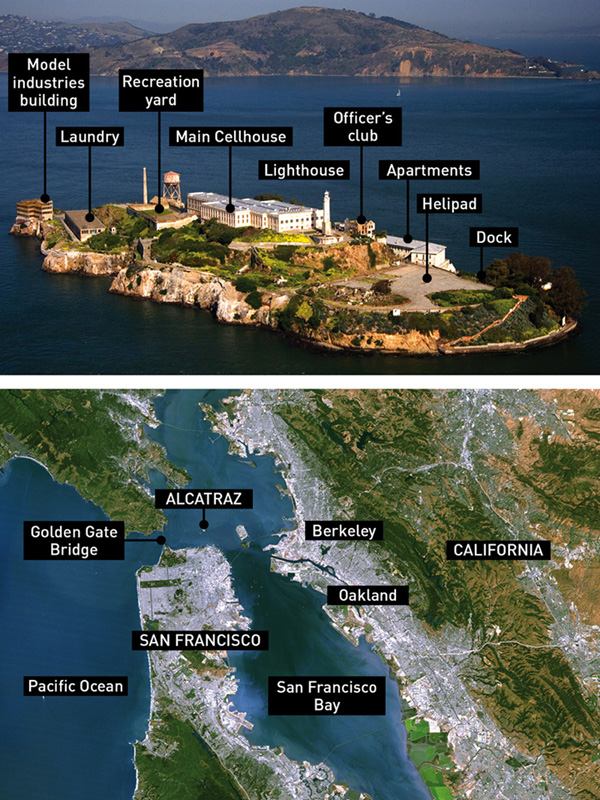100 Escape from Alcatraz
WHAT IT IS Emancipation from perhaps the most notorious prison of them all
WHY YOU WON’T DO IT These days, you won’t find yourself locked up there in the first place
Between 1934 and 1963, an outcrop sitting 2.5 kilometres (1.5 miles) out in San Francisco Bay, was the home of a federal prison from which no one is known to have successfully escaped. Should they reopen the prison and you’re unlucky enough to find yourself incarcerated there, you might want to follow the example of three jailbirds who might just have made it to freedom.
The Rock, as Alcatraz is also known, played host to a lighthouse, a military garrison and a military prison before it became a federal prison. Among its most famous inmates were Al Capone and Robert Franklin Stroud (the ‘Birdman of Alcatraz’ immortalized in the film of the same name). These days, a ferry that leaves from the city’s Pier 33 will take law-abiding tourists back and forth to Alcatraz as often as they wish.
Some 36 prisoners are known to have attempted a break-out from the prison’s confines in 14 separate incidents (sadly, despite the claims of the 1996 movie The Rock, Sean Connery was not among them). The most violent attempt, in 1946, resulted in the Battle of Alcatraz, a two day gun battle that left three prisoners and two warders dead.
Arguably the greatest escape attempt, however, was that made by Frank Morris and two brothers, John and Clarence Anglin, in June 1962. These three definitely made it off the island and into the water, and were never seen again.
NO WAY OUT An aerial view of the infamous prison at Alcatraz – once home to some of America’s most infamous prisoners. The Rock has not served as a penitentiary for more than half a century, and in 1986 it was designated a National Historic Landmark.
The official line is that they must have fallen victim to the bay’s dangerous currents, but there have always been stories that they succeeded in swimming across to San Francisco and starting new lives as free men. Regardless of their eventual fate, their escape plan was a remarkable example of ingenuity, patience and endurance – it inspired the 1979 Clint Eastwood movie Escape from Alcatraz, and has echoes in a rather more famous prison-escape story – The Shawshank Redemption. If you want to follow in their footsteps, then this is what you do:
• Fashion your tools out of the sight of guards. Use whatever comes to hand – Morris and the Anglins made a spoon by soldering the metal from a dime coin, and fashioned a drill from an old vacuum cleaner motor. This takes both patience and ingenuity – if you’re planning on attempting this kind of escpe, then you might want to take some sort of night class while you are still at liberty.
• Get yourself assigned to a cell in a suitable part of the prison (Cell Block B is ideal), locate an air vent and begin to scrape away the concrete around the protective grille using the tools you’ve made. Again, patience here is the key. The work might also be noisy – the 1962 escapees disguised the sound by working during the prison’s allotted music hour, and loudly playing the accordion throughout.
• When you are able to detach the grille, replace its metal rivets with fakes fashioned out of soap so that you can remove and replace it speedily without raising the suspicions of the guards.
• Prepare a papier-mâché dummy, complete with hair smuggled from the prison barbers, and position it in your bed so that any passing guards will be fooled.
• At an agreed time, remove the grille, enter the utility shaft and make your way onto the prison roof. It’s worth checking that all of your fellow escapees have gathered there before embarking on the next stage – Morris and the Anglins crucially forgot this, leaving a fourth cohort, Allen West, stuck in his cell and left to face the music.
• Climb down the outside of the building and make your way to the northeast shore. Using your prison-issue raincoats, fashion yourself a raft.
• Paddle like crazy and be prepared to get wet and swim for it!
Assuming you haven’t drowned (or been shot at by a vigilant guard), disappear into the crowds of San Francisco and live a little. And try to stay on the straight and narrow this time.
INSIDE THE BIG HOUSE A view down the main corridor of one of Alcatraz’s cell houses. The institution’s longest-serving prisoner was Alvin ‘Creepy’ Karpis, a gangster and one-time Public Enemy Number One. Convicted of robbery, kidnap and murder, he spent some 26 years on The Rock.

